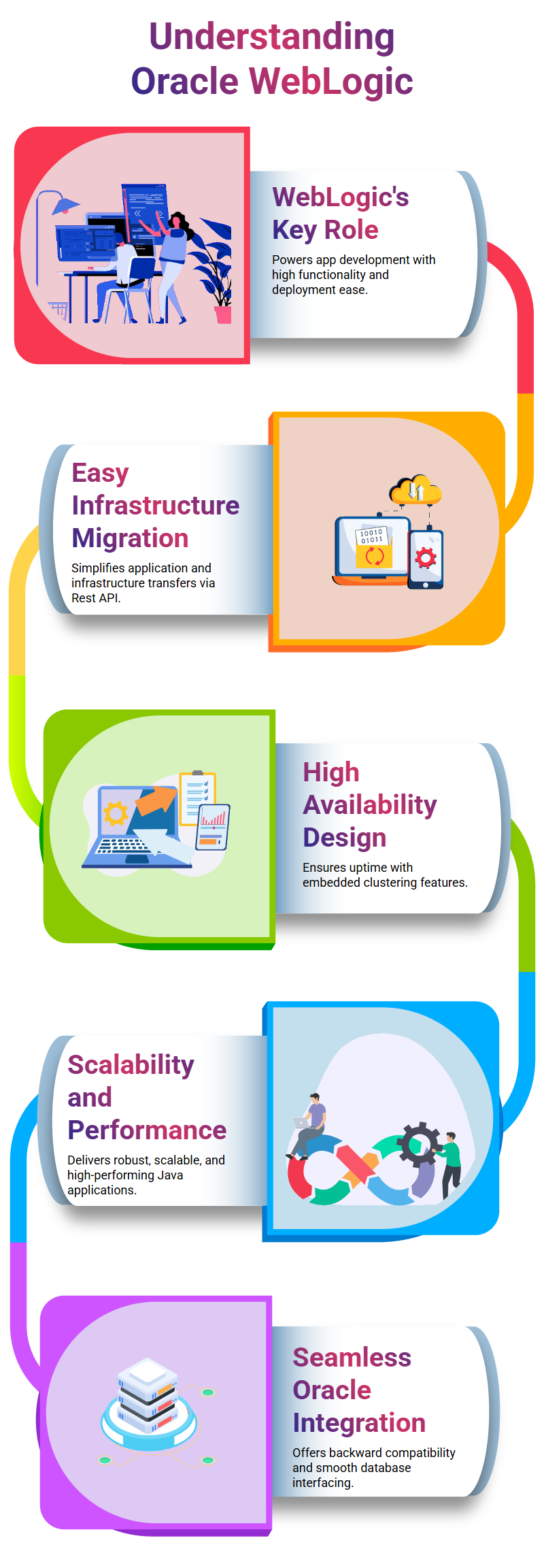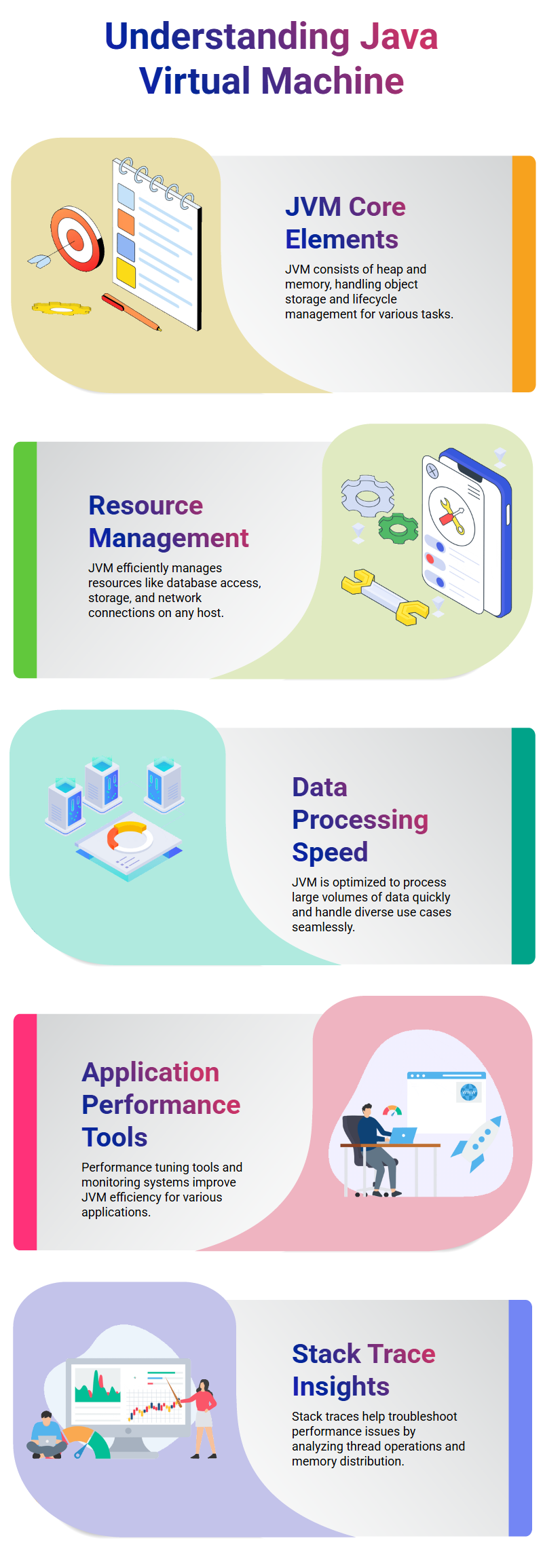What is WebLogic?
What is WebLogic?
WebLogic is a powerful tool for creating web applications, and understanding its capabilities and deployment methods will enable users to create effective and efficient web applications.
By gaining a basic understanding of WebLogic, users can design and implement solutions around the product, enhancing their skills and knowledge.
WebLogic is a leading web-based application provider that implements web logic, allowing customers to automate their management capabilities.
WebLogic provides infrastructure over a Rest API, enabling easy migration of applications and infrastructure.
WebLogic servers are known for their highly available architecture, which ensures high availability through embedded clustering capabilities.
Oracle WebLogic Server Components
Oracle WebLogic Server is a key component in the Java E Application Server market, serving as a foundation for numerous applications and solutions.
The server is capable of managing hundreds of JVMs but has limited resources. It has been proven to be secure and very good. Additionally, it is internally integrated, making it an ideal choice for developers looking for a reliable and efficient Java E Application Server.
Oracle WebLogic Server is a popular choice in the Java E Application Server market for several reasons, including scalability, performance, robustness, high availability, and internal integration. With so many options available, choosing the one that best suits your needs and requirements is essential.
WebLogic servers are known for their high performance and ability to handle connectivity with Oracle databases. They also offer a backward-compatible server, allowing customers running machines to upgrade their infrastructure easily.
WebLogic servers can be easily upgraded to newer versions, making them suitable for upgrading the server’s infrastructure. The server is part of the Oracle ecosystem, allowing unique integration with Oracle coherence and data layer components.

Heap dump
The heap dump dumps the entire memory allocation within a Java Virtual Machine (JVM) and analyses its contents. This process is crucial in identifying an application’s out-of-memory errors or memory leaks.
Heap dump analysis is used to identify whether the same memory leak occurs or is due to the same memory leak. In the log, the user can see that the file is out of memory or that the memory is being used repeatedly. If the user increases the memory, the file continues to be seen as out of memory.
When the user increases the memory, the error message indicates a memory leak. To detect this issue, the user must dump the heap dump, which is then used to analyse the memory usage within the application.
A heap dump is a crucial tool for analysing memory usage within an application. It helps identify out-of-memory errors or memory leaks, which can be identified through log analysis.
Oracle e-Business Suite in WebLogic
The Oracle e-Business Suite is essential for businesses looking to streamline their operations and processes.
It is a Java EE application server that can be deployed, run, and distributed to various systems such as databases, messaging, external enterprise, and cloud systems.
WebLogic, a suite component, allows users to write, run, and distribute Java applications.
WebLogic provides access to services like database messaging, external enterprise systems, and LDAP servers. It is used in both on-premise and cloud environments and is based on OPI E, Oracle Business Intelligence.
WebLogic has evolved from a separate application server to a more comprehensive solution for managing applications. Its capabilities include deploying, running, and distributing Java applications and connecting to other external services and LDAP servers.

12c in WebLogic
The application server in a BIS11 ID is a crucial component of the BIS software, which manages and executes applications. It is also used as an underlying application server for any cloud-based system. This service uses WebLogic, which is a popular choice for SAS software.
Enterprise Manager 13c is another application server that supports multi-tenancy, a feature available in 12c. This feature allows for partitioning features such as micro containers, which are divided into parts called partitions.
The application server in 12c is divided into multiple parts, known as partitions, which are further divided into smaller parts called micro containers. These containers are similar to WebLogic in terms of size and functionality.
The 12c application server supports WebLogic on top of Docker and the application server. This feature allows for creating multiple instances of the same application server, which can be used to manage and execute applications.
Java Virtual Machine (JVM)
The Java Virtual Machine (JVM) is divided into two main parts: the heap and the memory within the heap.
The heap is a collection of objects from both the young and old generation and other methods, such as permanent and permanent germination for different purposes.
The main areas of JVM are permanent generation and the program object’s life.

The JVM is a virtual machine that runs on a specific host computer, such as a server or a client. It manages the application’s resources and processes, such as the database, storage, and network connections.
The JVM is designed to handle large amounts of data and can handle large volumes of data.
The JVM is designed to handle large amounts of data and is flexible and adaptable, allowing it to be used in various scenarios.

Web Logic Online Training

Garbage Collections (GC)
GCs are a type of GC that can be serial-parallel. When a young generation fills up an area, a minor GC is kicked in, and when this area fills up, the application threads stop the application. This halts the application, causing it to stop and finish quickly.
There are two types of GCs: minor and major. Minor GCs are used to clean up unused objects in the application, while major GCs are used to stop applications and minimise the time spent running them.
GCs can be serial-parallel and used in various applications.
These include using a performance tuning tool, implementing a performance tuning strategy, and utilising a performance tuning tool.
Stack trace Tool
A stack trace is a tool for troubleshooting hanging or spinning Java applications. It can identify performance issues, such as a hang or taking longer than expected.
When a stack trace is created, it will not show memory, but it can provide information about the distribution for memory and the process being executed.
If there are stuck threads, a read dump may be necessary to dump them. This dump is a snapshot of all the threads in the application at that point.
Stack trace is a valuable tool for troubleshooting hanging or spinning Java applications. It can help identify performance issues, distribute memory, and determine the process ID for the form server’s JV. Using a stack trace, one can identify potential problems and take the necessary steps to resolve them.
Oracle HTTP Server
Oracle HTTP Server (OTD) is another critical component of this architecture. Users must have access to the load balancer and the web server.
Oracle provides recommendations for load balancers, and it is crucial to understand their usage and recommendations.
WebLogic Zero Two and Salumi Dean also guide connecting to JDBC or data sources. The discussion also covers connecting to the database and what the JDBC sees.
Virtual IP is a crucial aspect of cloud computing, and understanding its usage and recommendations can help improve performance and security. Developers can better manage their infrastructure and ensure optimal performance by understanding the architecture, configuration, and recommendations for load balancers.

Host
A host is a server that provides the application, which can be a software application or a representation of a machine.
The application can be a physical or virtual machine, depending on the type of machine.
The primary purpose of hosting is to ensure that the application is managed correctly and that it can handle the application’s requests and responses.
The application can be a that can application, which can be a representation of a machine, a physical machine, or a virtual machine. The application’s actions can be analysed and improved to serve the user’s needs better.
Conclusion
WebLogic is a robust and versatile platform for managing web applications, particularly those based on Java EE.
With its strong features like scalability, high availability, and seamless integration with Oracle services, WebLogic is a leading choice for enterprises seeking reliable infrastructure for running and distributing Java applications.
The server’s capabilities, including memory management tools like heap dumps, garbage collection strategies, and performance monitoring tools such as stack traces, ensure efficient operation and troubleshooting.
Furthermore, the integration of WebLogic with Oracle’s e-Business Suite, its support for cloud and on-premise environments, and its adaptability to various deployment needs make it a vital tool in modern enterprise IT architectures.
Understanding WebLogic’s components and configuration options empowers developers and IT administrators to optimize application performance and infrastructure management effectively.

Navya Chandrika
Author

